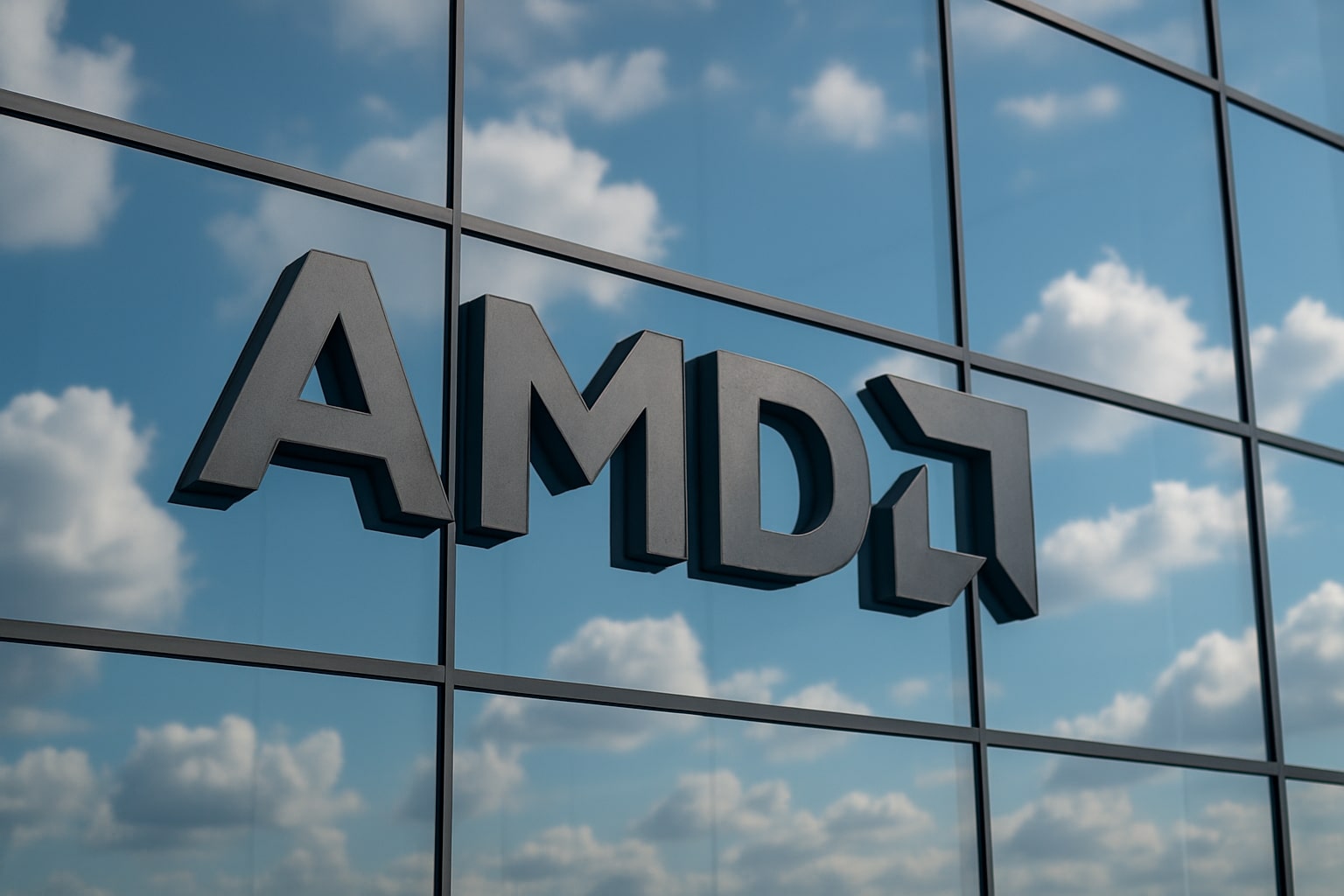
AMD Stock Price Forecast - AMD Holds $232.49 as OpenAI and Oracle AI GPU Deals Ignite $300 Price Target
AMD nears $241.20 high as OpenAI’s 6-GW GPU deal and Oracle’s 50K-chip plan lift 2026 revenue outlook to $42B and spark $300 price targets | That's TradingNEWS
AMD (NASDAQ:AMD) Climbs to $232.49 as OpenAI Partnership and AI GPU Expansion Reprice Its 2026–2027 Trajectory
Advanced Micro Devices Inc. (NASDAQ:AMD) is trading near $232.49, down 0.88% on October 17, 2025, yet holding just below its 52-week high of $241.20. The company’s valuation has surged to $377.24 billion, reflecting a year-to-date return above 92%, fueled by record-breaking AI partnerships, accelerating data center growth, and rising investor confidence in its ability to rival NVIDIA (NASDAQ:NVDA) in next-generation GPU dominance. The stock’s P/E ratio of 133.82 and forward multiple of 28.57 suggest that the market has priced AMD as a long-term structural winner in artificial intelligence hardware.
AI Partnerships Transform AMD’s Revenue Outlook
The defining catalyst for AMD’s revaluation is its landmark partnership with OpenAI, which secured a 6-gigawatt GPU deployment commitment beginning in the second half of 2026. The deal centers around AMD’s Instinct MI450 GPUs, set to power OpenAI’s expanding infrastructure for ChatGPT and other large language model applications. The agreement also includes a warrant granting OpenAI rights to acquire up to 160 million AMD shares, tied to both deployment milestones and share price targets that reach as high as $600 per share.
This structure could inject tens of billions of dollars in new annual revenue by 2027, positioning AMD to cross $100 billion in total sales within the next three to four years if subsequent hyperscaler demand follows. Barclays raised its AMD price target to $300, estimating the OpenAI deal could lift EPS by $1.30 per share and add $4.5 billion in quarterly revenue once fully ramped. With each additional gigawatt of GPU deployment translating to roughly $15 billion in incremental sales potential, AMD’s long-term trajectory has shifted from cyclical to secular expansion.
Oracle and Hyperscaler Integration Fuel Market Penetration
Beyond OpenAI, AMD’s partnership with Oracle (NYSE:ORCL) reinforces its status as a top-tier AI infrastructure provider. Oracle announced plans to deploy 50,000 MI450 GPUs by late 2026 in a massive AI supercluster powered by AMD’s EPYC Venice (Zen 6) CPUs. This marks the largest GPU collaboration in Oracle’s history, complementing AMD’s existing footprint across Microsoft Azure, Meta Platforms, and Amazon Web Services (AWS).
The Oracle deal is projected to deliver roughly $20 billion in cumulative hardware revenue, underscoring AMD’s ability to scale GPU sales across major cloud operators. This diversification is critical, as hyperscaler budgets for AI infrastructure are expected to exceed $200 billion annually by 2028, and AMD’s flexible pricing has made it an attractive alternative to NVIDIA’s premium models.
Financial Performance and Valuation Dynamics
AMD’s financial profile has strengthened sharply across all metrics. Trailing twelve-month revenue stands at $29.6 billion, with a net income of $2.73 billion and EPS of $1.67. Quarterly revenue growth accelerated 31.7% year-over-year, while operating income reached $2.45 billion in the most recent quarter. The company’s profit margin of 9.57% and return on equity of 4.7% remain below NVIDIA’s levels, but analysts expect a major step-up in profitability as AI-driven margins expand.
Free cash flow surged 280% year-over-year in Q2 2025, hitting $2.33 billion, supported by $5.87 billion in cash against just $3.89 billion in long-term debt — a modest 6.5% debt-to-equity ratio. With an operating cash flow of $4.88 billion, AMD has the flexibility to reinvest aggressively in AI silicon, memory bandwidth upgrades, and on-premise accelerator systems while maintaining balance sheet strength.
Valuation-wise, AMD trades at 9.36× price-to-sales, 4.62× price-to-book, and EV/EBITDA of 48.8×. While this premium is high relative to peers like Intel (NASDAQ:INTC) at 17.9× P/E or Broadcom (NASDAQ:AVGO) at 37.4×, it reflects AMD’s structural growth in a $1 trillion AI chip market. The company’s PEG ratio of 0.52 indicates earnings growth is still outpacing valuation expansion — a critical sign that current multiples remain supported by fundamentals.
Earnings Acceleration and Analyst Upgrades
AMD delivered $7.68 billion in Q2 FY25 revenue and $781 million in net earnings, matching consensus EPS expectations of $0.48. Analysts now forecast $8.74 billion in Q3 revenue and $9.17 billion in Q4, with full-year 2025 revenue projected at $33.1 billion and 2026 revenue at $42 billion — representing a 27% annualized growth rate. EPS estimates stand at $3.93 for 2025 and $6.29 for 2026, up sharply from 2024’s $3.31.
Bank of America Securities reiterated its Buy rating and lifted its price target from $250 to $300, while consensus across 47 analysts averages $239.11, with the most bullish targets approaching $310. Importantly, AMD’s earnings surprise record has remained steady, outperforming expectations in 10 of the last 12 quarters.
AI GPU Revenue Expansion and Margin Outlook
The OpenAI and Oracle partnerships mark an inflection point for AMD’s Data Center segment, which is expected to generate over $3 billion per quarter in AI GPU sales by 2026, tripling its 2024 pace. Management forecasts that AI-related products could account for 40% of total company revenue by 2027, versus less than 10% in 2023.
The Instinct MI350 and MI450 lines have been designed to close the performance gap with NVIDIA’s H100 and forthcoming Blackwell GPUs, achieving significant efficiency gains in inference workloads. These units are priced between $25,000 and $30,000 each, with early demand exceeding expectations. If AMD captures even 15–20% of the merchant GPU market projected to reach $750 billion by 2030, total revenue could top $150 billion within the decade.
Gross margin, currently at 47.6%, is expected to surpass 50% again by late 2026 as high-value GPU shipments offset cost pressures from legacy CPU and gaming divisions. Analysts anticipate operating margin expansion toward 25%, narrowing the gap with NVIDIA’s 40%+ range.
Read More
-
VOO ETF Hits $630 as Fed Shift and AI Growth Power 2026 Rally Toward $700
07.12.2025 · TradingNEWS ArchiveStocks
-
XRP ETFs XRPI & XRPR Aim for $1B Inflows as XRP Holds $2.02 Support
07.12.2025 · TradingNEWS ArchiveCrypto
-
Natural Gas Price (NG=F) Rallies to $5.29, Freezing Temperatures Spark Bullish Breakout
07.12.2025 · TradingNEWS ArchiveCommodities
-
USD/JPY Price Forecast - Dollar Extends Slide to 154 as BoJ Hawkish Pivot Drive Yen Toward 150
07.12.2025 · TradingNEWS ArchiveForex
Long-Term Scenarios and Free Cash Flow Expansion
Financial modeling suggests AMD’s Free Cash Flow margin could climb from 12% in 2025 to 30–40% over the next decade, driven by improved utilization rates, higher ASPs, and data center mix. Under a base case, AMD’s fair value lands between $219 and $300 per share; in a bull case where AI GPU sales hit $30 billion annually by 2027, the valuation extends toward $457, with extremely aggressive models suggesting upside to $600 if OpenAI’s warrants fully vest and EPS rises above $12 by 2027.
This momentum places AMD in direct competition with NVIDIA’s scale and pricing, but unlike previous cycles, AMD’s strategy emphasizes margin recovery over market share grabs. This disciplined pricing is expected to maintain EPS compounding at 60% annually through 2026, according to revised consensus models.
Insider and Institutional Positioning
Institutional confidence in AMD (NASDAQ:AMD) remains strong, with major holders like Vanguard, BlackRock, and Fidelity collectively owning nearly 69% of the float. Insider ownership remains low at 0.5%, but key executives, including CEO Dr. Lisa Su, have consistently maintained positions aligned with long-term performance. Full insider activity and recent institutional shifts can be tracked at TradingNews.com’s insider section.
Short interest remains modest at 2.34% of float, suggesting little speculative pressure. The stock’s beta of 1.89 reflects heightened sensitivity to market momentum, but its 50-day moving average at $174.95 and 200-day at $132.49 confirm a strong technical uptrend.
Investment View and Price Target
AMD’s trajectory has fundamentally shifted. With a strong balance sheet, surging AI revenue visibility, and multi-hyperscaler demand, the company is positioned to deliver structural growth rather than cyclical rebounds. At $232.49, AMD trades below its 1-year target estimate of $239.11, offering near-term upside of 3–4%, and a medium-term path toward $300–$310 based on current EPS revisions.
While near-term volatility may arise around earnings in November, the underlying AI cycle — anchored by OpenAI, Oracle, and Microsoft deployments — sets the foundation for multi-year compounding.
Verdict: At current valuation and growth trajectory, AMD (NASDAQ:AMD) is a Buy. The company’s expanding AI ecosystem, accelerating data center profitability, and credible path toward 50%+ margins justify its premium. With institutional accumulation rising and its 2027 EPS potential near $12, AMD remains one of the most strategically positioned semiconductor plays of the decade.
Real-time price updates are available at AMD


















